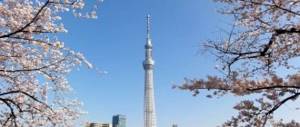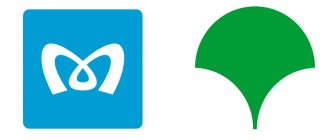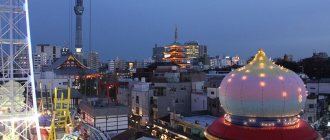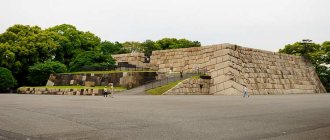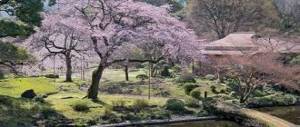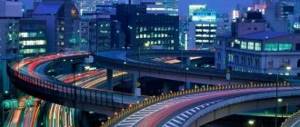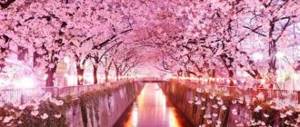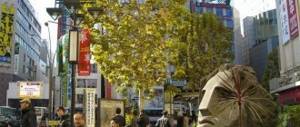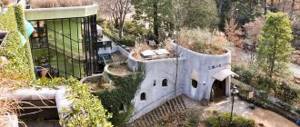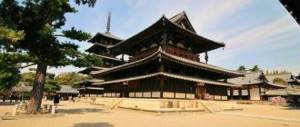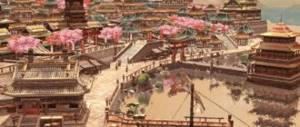Author:
Galina
15:30 | 11.01.2017
Heading:
Attractions
700
400
One of the most famous towers in the world stands in the capital of Japan. Residents are proud of this building, considering it the hallmark of the city. The Tokyo Tower took 18 months to build. Initially, they decided to build it for technical purposes. Television was rapidly conquering the world; several companies operated in Tokyo, broadcasting to the city and surrounding areas. At some point, the city authorities realized that television crews would build up the territory with antennas in order to increase the coverage area and attract new viewers. Spontaneous construction could damage the beauty of Tokyo. Under the influence of the authorities, the companies agreed to build one structure, the capabilities of which would be sufficient for everyone.
View of Tokyo from the tower.
Tokyo Skytree offers the best views of Japan's capital. The tower is very tall and has two special 360-degree panoramic observation decks.
Tembo Deck observation deck
The first observation deck is located at an altitude of 350 meters, which already provides an excellent overview. Tembo , the lower of the two platforms, spans three levels with magnificent views from all floors. On the top floor there are tall, wide windows that offer one of the best panoramic views of the city. The middle floor houses a gift shop and the Musashi Sky restaurant. On the lower floor there is a cafe and several glass panels on the floor, from where you can see all the way to the base of the tower.
Tembo Deck observation deck
Tembo Gallery
But the best view of Tokyo is from the second observation deck at an altitude of 450 meters. Dubbed "the world's tallest skywalk", the Tembo Gallery consists of an inclined spiral ramp that gains height in a circle around the tower. The steel and glass tube structure allows visitors to look down and tens of kilometers into the distance from the tower's dizzying heights.
In addition, there is an overhanging balcony that extends five meters around the tower and is made entirely of glass. This allows you to look straight down from 450 meters! Therefore, this is not a place for people who suffer from altitude. This floor is officially located at an altitude of 451.2 meters and is the highest point of the observation deck.
Spiral ramp of the Tembo Gallery observation deck
The view is unparalleled in Tokyo both during the day and in the evening. We can recommend that you start your Tokyo tours from the Skytree. The high altitude will give you an idea of how the city works and can help you navigate the giant metropolis.
Visit Skytree early in the morning or late in the evening. Only a limited number of people are allowed on the viewing platforms, so be prepared for a short line. A visit to the highest platform costs about 30 euros per person and 15 euros for a child under 18 years old.
History of Tokyo Tower
In 1953, public broadcaster NHK began its first television broadcasts in the Kanto region. Japan at the time was experiencing a construction boom driven by rapid economic growth. Everyone needed a television tower: small private companies, NHK, the authorities. The project was led by Hisakichi Maeda, founder and director of Nippon Denpatō.
Initially it was planned to build the tallest structure in the world. However, due to the lack of necessary funds, we settled on the current project. The height of the tower is 332.6 meters. Manufacturing material – steel. It ranks 23rd on the list of the 29 tallest television towers. Construction began in June 1957 and lasted 18 months. Interestingly, some of the steel for the structures was obtained by melting down old American tanks that were damaged and left on the battlefields.
According to Japanese sources, 220,000 workers were involved in construction at a time (maximum). 30 million US dollars were invested in the project. The chief architect, Tachyu Naito, took the design of the Eiffel Tower as a basis. Thanks to more modern technologies, Tokyo Tower turned out to be much lighter. Its structure weighs 4 thousand tons, which is 3.3 thousand tons less than the calling card of Paris.
The television tower hid behind trees and houses
Tokyo Skytree. Safety
About 1,500 earthquakes occur every year in Japan. Many of these earthquakes are too small in size, but some have caused significant damage.
Therefore, the Tokyo Skytree is attached to a frame that functions as a kind of hammock, moving with it to dampen ground vibrations. This makes Tokyo Skytree resilient enough to withstand severe earthquakes.
Loss of technical significance
Tokyo Tower was not damaged by an earthquake, but due to the development of technology. Its height was not enough for analogue broadcasting. In 2012, a new 634-meter Tokyo Skytree tower was built. Radio broadcasting companies have remained in the old tower and its tourist attraction has been preserved.
Back in 1989, Tokyo Tower was equipped with 176 powerful floodlights. They are used during the show to attract tourists, as well as to illuminate the structure itself. For example, at Christmas the New Year's numbers light up on the tower. On some special dates its lighting changes. So, 01.10.2000 Breast Cancer Awareness Month has begun. To commemorate this date, the tower glowed pink and now every year on October 1st the tower is painted pink.
Despite the emergence of more convenient designs in the region, Tokyo Tower remains a symbol of Tokyo. Her stylized image is often used in anime, manga, and Japanese horror (kaiju) films. The tower has twin mascots. These are humanoids dressed in overalls of different colors (red and blue). Both are named Noppon. The talismans appeared or were “born” for the fortieth anniversary of the tower.
TV and radio channels in Tokyo Skytree.
The most modern television tower broadcasts radio and television throughout Tokyo. Major TV channels such as NHK General TV, NHK Educational TV, Nippon Television, TV Asahi, Tokyo Broadcasting System Television, TV Tokyo and Fuji Television are located here.
In addition, Skytree broadcasts NHK Radio 1 Tokyo, NHK Radio 2 Tokyo and NHK FM. Previously, almost all of these channels were broadcast through the orange Tokyo Tower. The taller and more modern Skytree has a much wider range and can also broadcast the higher frequencies needed for digital television.
A few words about the town
The most populated part of the capital of Japan is the Sumida area. The name of this area is given after the Sumida River. This part of the city was formed in March 1947. According to census estimates, as of April 1, 2021, there are 266 thousand people living in Sumida.
The Sumida TV Tower opened in 2012 for tourists to visit. This area is rich in cultural life, and it is recommended to visit a couple of tourist spots, in addition to the radio communications tower.
For example, travelers will find it fascinating to look at the exhibits at the History Museum (Edo-Tokyo Museum). It is also recommended to visit the Tobu Railway Museum, Honjo Matsuzaka-Cho Park, and the Edo Period Flower Garden.
Opening hours and entrance fee
The entrance to Tokyo Skytree is located on the 4th floor of Tokyo Skytree Town. Additionally, it is a 20-minute walk across the Sumida River from Asakusa.
A visit to the Tokyo Skytree begins on the 4th floor, where tickets for the first observation deck (but not the second) are sold. A fast and smooth elevator ride takes visitors to the top floor of the first observation deck, where tickets for the second observation deck can be purchased. Visitors then gain access to the second deck and descend back to the lower floors of the first observatory, where they take an elevator to the tower exit on the 5th floor.
The Sky Tree is open from 8:00 to 22:00 (you can enter before 21:00) on all days of the year, including holidays. There are two types of tickets.
Same day ticket
Same day tickets can be purchased at the box office on the 4th floor. On busy days (typically when wait times exceed one hour), patrons will be assigned a 30-minute slot during which they can enter. On very busy days, same day tickets may sell out (maximum 10,000 per day).
Skytree ticket
Skytree Fast Tickets are a special type of ticket available only to foreign tourists (and Japanese accompanying foreign tourists). They are more expensive than regular tickets, but allow holders to skip the line and go up the tower without waiting. Tickets are sold at a separate box office on the 4th floor. Passport required at time of purchase.
- First site: 2100 yen (weekdays), 2300 yen (weekends and holidays) Both sites: 3100 yen (weekdays), 3400 yen (weekends and holidays)
- For foreign tourists only: Fast Skytree single ticket (first observatory): 3,200 yen Fast Skytree combined ticket (both observatories): 4,200 yen.
1 Japanese yen is equal to 59 Russian kopecks.
Views: 3,052
Share link:
- Tweet
- Share posts on Tumblr
- Telegram
- More
- by email
- Seal
Location and exact address
When traveling around Japan, you can easily get lost, especially in such a large metropolis as Tokyo. To find the location of Tokyo Sky Tree, tourists first of all get to the Sumida area by several means of transport:
- metro;
- bus.
The Tokyo Skytree landmark can be seen from afar, from almost any part of the capital, since the spire of the television tower is located at an altitude of 634 meters. You can get to Tokyo Sky Tree Town by visiting the address: Oshiage 1-1-13.
Attention! From Asakusa Station, you can cross the Sumida River in 20 minutes and end up at the famous Sky Tree.
"634" and other interesting facts
Tokyo Skytree has an extended structure at the base, so the attraction was built more than half a kilometer into the sky. To maintain proportions, the builders needed to build a base of 181 meters. But some difficulties arose due to lack of space. The site on which the structure was erected was first expanded by 8 meters. After this, a triangular base of the structure was erected, similar to a tree with its cone-shaped shape and a height of 634 meters.
Construction process
By the end of the 2000s, Japan had to completely abandon analogue television and switch to digital format. However, it soon became clear that the main (at that time) Tokyo television tower was too low and could not provide high-quality data transmission to the upper floors of many skyscrapers. The Japanese made a decision: to build a taller tower.
Construction began in the summer of 2008 and was completed in May 2011. A year later, its grand opening took place. The pace of construction was truly impressive - up to 10 meters per week!
The parameters of the land plot allocated for the construction of the “Sky Tree” in Tokyo were minimal - 400 by 100 meters. It was simply impossible to lay a traditional square foundation of the required size on this piece of land. Therefore, the architects decided to erect a tower on a triangular foundation with a width of 68 meters on each side.
Then the creators faced another problem. It was necessary to build circular observation platforms that would provide a 360-degree panoramic view of the city. The designers found a solution: they began to build the tower from a triangular base, gradually rounding its shape.
Architectural features
The design of the building was developed long before construction began. In 2006, the architects decided to build a teleradiocommunication structure in a neo-futuristic format. In addition, such a design had to be in harmony with Japanese traditions. It was also important to make the building durable: it should not collapse or be at risk during earthquakes.
Worth knowing! A special underground system under the tower compensates for up to 50% of underground vibrations during an earthquake.
“Tree of Heaven” (Tokyo): photos and general characteristics of the tower
The Tokyo Broadcasting Tower is one of the top 5 largest television towers in the world. Moreover, it is the absolute leader in height among other similar structures. This is clearly visible in the diagram below. It is taller than the famous Canton Tower in Guangzhou and almost a hundred meters higher in height than the Ostankino Tower.
The name of the Tokyo Tower is beautiful and symbolic - “Tokyo Sky Tree”. He was chosen by popular vote via the Internet. The design height of the Sky Tree in Tokyo is 634 meters (including antenna). The total number of floors is 29. The tower houses 9 different television companies and two radio broadcasting companies.
By the way, the product line of the famous Chinese manufacturer Loz includes the “Tokyo Sky Tree” construction set (630 pieces). It is curious that the total number of parts in it is 630, which is almost equal to the height of the real building. The construction set consists of modern nanoparts, which allows you to assemble a model that is as close as possible in appearance to the original.
